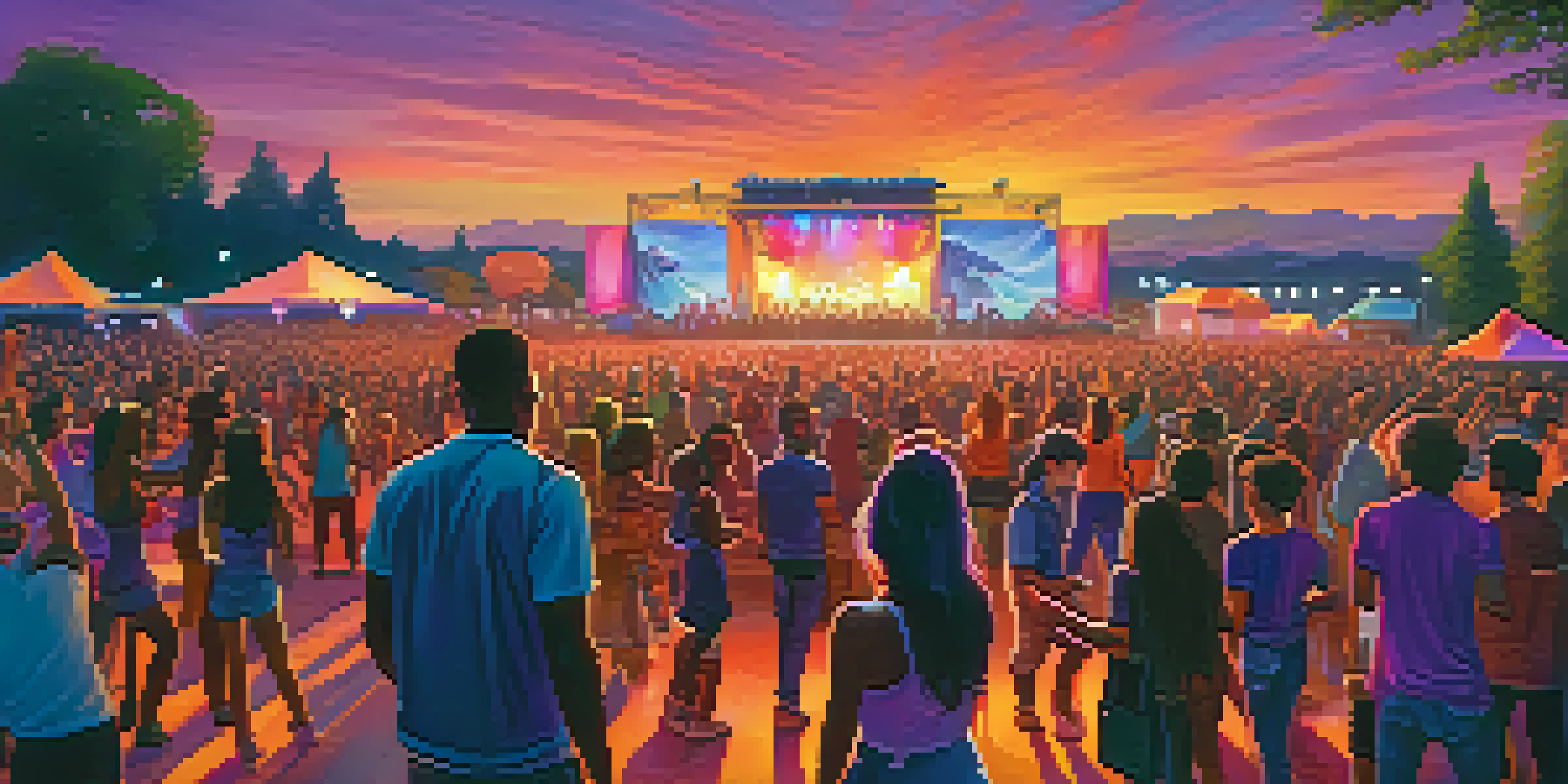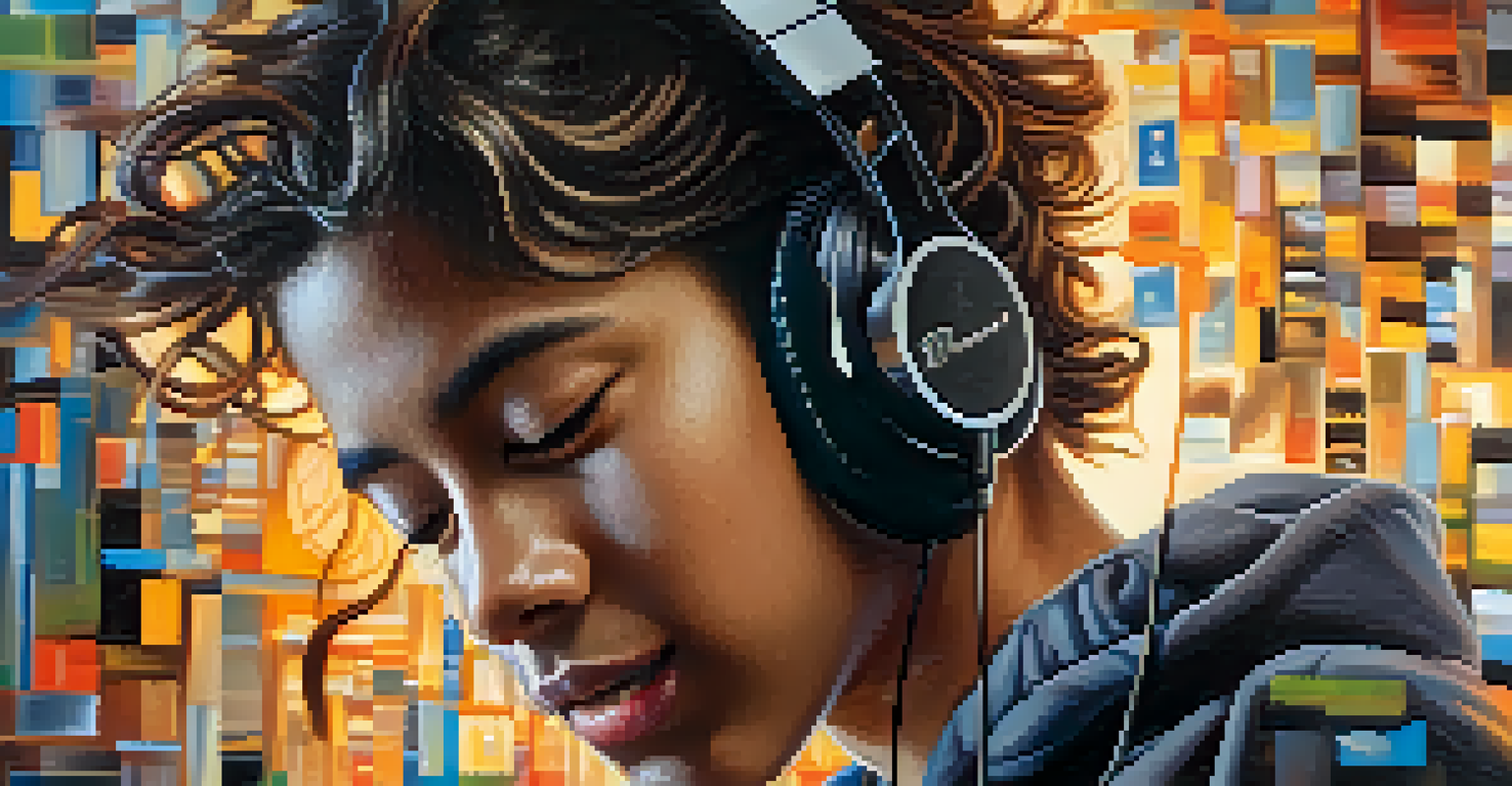Exploring the Soundtrack of Youth: Genres and Trends

The Evolution of Youth Music: A Brief Overview
Music has always been a vital part of youth culture, shaping identities and experiences. From the rebellious rock 'n' roll of the 1950s to the vibrant hip-hop of today, each era has brought new sounds that echo the sentiments of young people. This evolution mirrors societal changes, reflecting everything from political movements to technological advancements.
Music can change the world because it can change people.
As we delve into the evolution of youth music, we notice how genres often arise in response to cultural shifts. For instance, punk rock emerged in the 1970s as a reaction to disillusionment with mainstream society. Similarly, the rise of electronic dance music (EDM) in the 2000s highlighted a desire for escapism and connection in an increasingly digital world.
Understanding this evolution not only helps us appreciate the music but also the youth culture it represents. Each genre tells a story, encapsulating the hopes, struggles, and voices of young people. This connection between youth and music is timeless, making it a fascinating area to explore.
Key Genres That Define Teenage Experiences
Different genres resonate with youth for various reasons, often reflecting their experiences and emotions. Pop music, with its catchy hooks and relatable lyrics, often becomes the soundtrack for young love and heartbreak. Meanwhile, rock music channels feelings of rebellion and freedom, making it a staple for those seeking to express their individuality.

Hip-hop, on the other hand, has grown to become one of the most influential genres among youth today. Its roots in storytelling and community speak to the struggles and aspirations of young people across diverse backgrounds. This genre not only entertains but also serves as a powerful vehicle for social commentary.
Music Reflects Youth Culture
Youth music evolves alongside societal changes, capturing the hopes and struggles of young people through various genres.
Don't overlook the influence of indie and alternative music, which often resonates with those seeking something outside the mainstream. These genres provide an avenue for self-discovery and authenticity, allowing young listeners to carve out their unique identities through sound.
The Impact of Social Media on Music Trends
In today's digital age, social media has transformed how music is consumed and promoted. Platforms like TikTok and Instagram allow songs to go viral overnight, creating trends that can define a generation. This immediacy has empowered young artists and independent musicians to reach audiences without traditional gatekeepers.
Without music, life would be a mistake.
Moreover, social media has fostered communities around specific genres and artists. Fans can connect, share, and discuss their favorite tracks, creating a sense of belonging that transcends geographical boundaries. This interconnectedness has inspired a new wave of collaboration among artists, blending genres and styles in innovative ways.
As trends rapidly evolve, young listeners are at the forefront, shaping what becomes popular. Their preferences often dictate which songs are played on repeat, making social media not just a tool for discovery but a driving force behind music trends.
Live Music: A Catalyst for Youth Culture
Live music experiences, from concerts to music festivals, create unforgettable memories for young people. These events serve as gathering places where fans can unite over shared passions, forming connections that often last a lifetime. The thrill of experiencing favorite artists perform live is a rite of passage for many.
Concerts also provide a unique platform for self-expression, allowing youth to showcase their individuality through fashion and dance. The energy in the crowd fosters a sense of community, where everyone shares in the collective experience of music. This sense of belonging is crucial during formative years, helping shape personal identities.
Social Media Shapes Music Trends
Platforms like TikTok and Instagram empower young artists and influence music trends, allowing for rapid discovery and community building.
Additionally, live music often reflects the cultural and social issues of the time. Many artists use their platforms to advocate for change, resonating with young audiences who are eager to make their voices heard. This intersection of music and activism creates a powerful experience that amplifies the soundtrack of youth.
Nostalgia: How Past Genres Influence Today's Youth
Nostalgia plays a significant role in shaping the music preferences of today's youth. Many young people find themselves drawn to genres and artists from previous decades, often through their parents' influence. This blend of old and new creates a rich tapestry of musical appreciation that transcends time.
For instance, the resurgence of 80s synth-pop and 90s grunge in contemporary music illustrates this nostalgic trend. Young artists often sample or pay homage to these styles, breathing new life into classic sounds. This practice not only honors past influences but also allows for creative reinterpretation that resonates with current audiences.
This blending of eras creates a unique listening experience, where youth can appreciate the roots of their favorite genres while still feeling modern. It highlights the cyclical nature of music, where every generation finds inspiration in the past to shape their future.
The Role of Lyrics in Shaping Youth Identity
Lyrics are often the heartbeat of a song, providing context and meaning that resonates deeply with listeners. For many young people, the words in a song can articulate emotions and experiences they struggle to express. This connection can be incredibly validating, helping them navigate their feelings during turbulent times.
Artists like Taylor Swift and Billie Eilish have gained immense popularity partly due to their relatable lyrics. They tackle themes of love, heartache, and self-discovery, reflecting the complexities of growing up. These narratives create a sense of solidarity among listeners who feel understood and less alone in their experiences.
Live Music Fosters Community
Concerts and festivals create shared experiences that unite young people, serving as crucial spaces for self-expression and connection.
Moreover, powerful lyrics can inspire action, prompting young people to engage in social issues. Music becomes a form of protest or advocacy, encouraging youth to raise their voices and fight for change. This dual role of lyrics as both a source of comfort and a call to action solidifies their importance in youth culture.
Conclusion: Celebrating the Soundtrack of Youth
As we explore the soundtrack of youth, we uncover the profound impact music has on shaping identities and experiences. From the genres that define our moments to the lyrics that resonate with our struggles, music remains a timeless language that connects us all. It's a vibrant tapestry woven from the threads of nostalgia, innovation, and community.
In celebrating this soundtrack, we acknowledge the diverse influences that shape young people's lives today. Whether through live music, social media, or the power of lyrics, each element plays a crucial role in crafting a unique experience that reflects their journey. The songs we listen to often become the backdrop to our most memorable moments.

Ultimately, the soundtrack of youth is a living, evolving entity that continues to inspire and unite. As new trends emerge and genres blend, one thing remains clear: music will always be a central part of the youth experience, guiding them through the complexities of growing up.